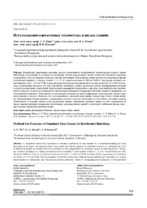| dc.contributor.author | Пиир, А. Э. | ru |
| dc.contributor.author | Козак, О. А. | ru |
| dc.contributor.author | Кунтыш, В. Б. | ru |
| dc.coverage.spatial | Минск | ru |
| dc.date.accessioned | 2017-04-03T07:55:00Z | |
| dc.date.available | 2017-04-03T07:55:00Z | |
| dc.date.issued | 2017 | |
| dc.identifier.citation | Пиир, А. Э. Пути снижения нормативных теплопотерь в жилых зданиях = Method for Decrease of Standard Heat Losses in Residential Buildings / А. Э. Пиир, О. А. Козак, В. Б. Кунтыш // Наука и техника. – 2017. – № 2. - С. 113–118. | ru |
| dc.identifier.uri | https://rep.bntu.by/handle/data/29245 | |
| dc.description.abstract | Разработана упрощенная методика расчета нормативного коэффициента теплопередачи жилого здания. Выполнены исследования по влиянию на суммарные теплопотери размеров здания уровня теплоизоляции наружных ограждений и доли регенерации теплоты в системе вентиляции. Рассмотрены здания простой геометрической формы («спичечный коробок») с числом этажей 1; 2; 4; 8; 16, жилой площадью от 100 до 25600 м2 при уровне теплового сопротивления стен 1; 3 и 5 м2⋅оС/Вт и доле регенерации теплоты вентиляционного потока воздуха 0; 0,5 и 0,66. Результаты исследования показали, что при увеличении габаритов здания происходит резкая трансформация размеров и структуры наружных ограждений: доля площади перекрытий сокращается в три раза; доля площади стен увеличивается в два раза. В шесть раз уменьшается доля площади поверхности наружной оболочки здания по сравнению с ее отапливаемой площадью. Отнесенный к отапливаемой площади средний коэффициент теплопередачи здания становится меньше в три раза. Показано, что для дальнейшего снижения нормативных теплопотерь жилых зданий наиболее эффективными путями являются: рекуперация теплоты в системе вентиляции (и тем глубже, чем выше уровень теплозащиты и холоднее климат зоны сооружения здания); укрупнение размеров зданий за счет уменьшения их числа; сверхнормативное повышение теплозащиты малоквартирных зданий и коттеджей; кубическая форма двух-, трехэтажных зданий для Крайнего Севера. | ru |
| dc.language.iso | ru | ru |
| dc.publisher | БНТУ | ru |
| dc.subject | Рекуперация теплоты | ru |
| dc.subject | Теплопотери | ru |
| dc.subject | Жилые здания | ru |
| dc.subject | Heat recovery | en |
| dc.subject | Heat losses | en |
| dc.subject | Residential buildings | en |
| dc.title | Пути снижения нормативных теплопотерь в жилых зданиях | ru |
| dc.title.alternative | Method for Decrease of Standard Heat Losses in Residential Buildings | en |
| dc.type | Article | ru |
| dc.relation.journal | Наука и техника | ru |
| dc.identifier.doi | 10.21122/2227-1031-2017-16-2-113-118 | |
| local.description.annotation | A simplified method for calculation of standard coefficient for heat transfer in a residential building has been developed in the paper. Investigations have been carried out with the purpose to determine influence of building size, level of thermal insulation in external enclosures and share of heat regeneration in ventilation system on total heat losses. The paper considers buildings of a simple geometrical form ("matchbox") with number of floors 1, 2, 4, 8, 16 and living area from 100 up to 25600 m2 at the level of thermal resistance of walls 1; 3 and 5 m2⋅°C/W and share of heat regeneration in ventilation air stream of 0; 0.5 and 0.66. The investigation results have shown that while increasing building size then there is a sudden transformation of dimensions and structure in external enclosures: share of overlapping area is reduced by 3-fold and share of wall area is increased by 2-fold. Surface area of building external envelope is reduced by 6-fold in comparison with its heated area. An average coefficient of building heat transfer assigned to heated area is decreased by 3-fold. It has been shown that the most efficient methods for further decrease of standard heat losses for residential buildings are the following: heat recovery in the ventilation system: it is deeper if heat protection rate is higher and climate of a building construction zone is colder; enlargement of building size through decrease of their number; limit-exceeding increase in heat protection of small apartment buildings and cottages; cubic form of 2–3-floor buildings for Far North. | en |

